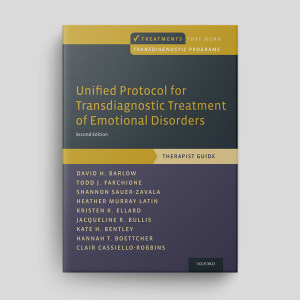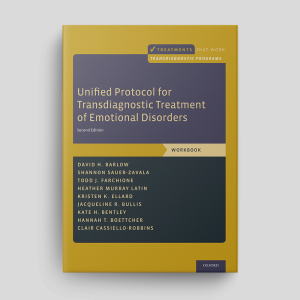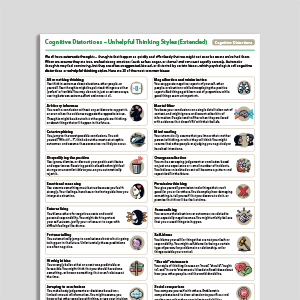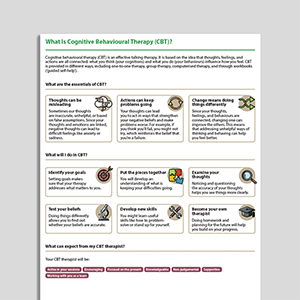Manage Your Mind: The Mental Fitness Guide (Third Edition)
Manage Your Mind: The Mental Fitness Guide is a trusted self-help resource that equips clients with effective strategies for building psychological resilience and improving wellbeing.
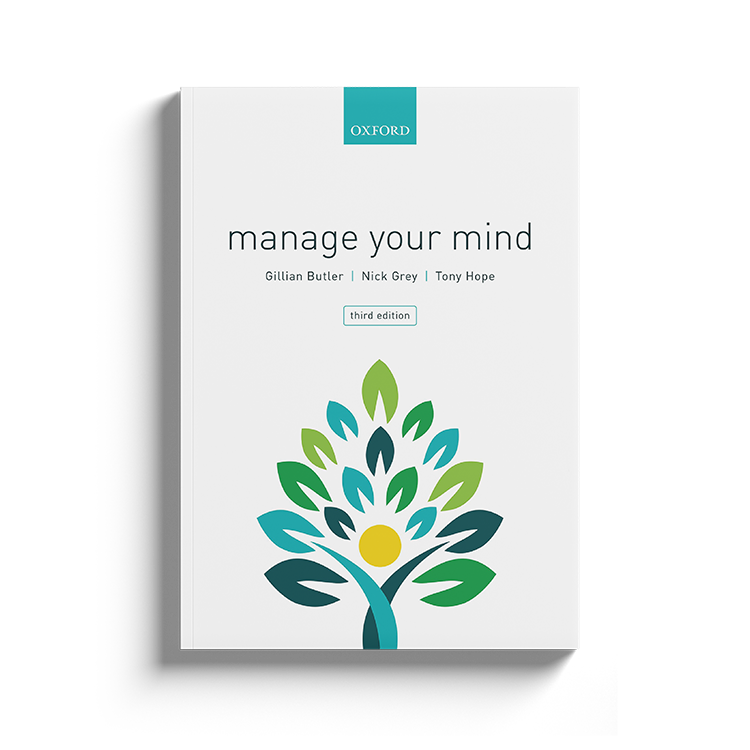
Download or send
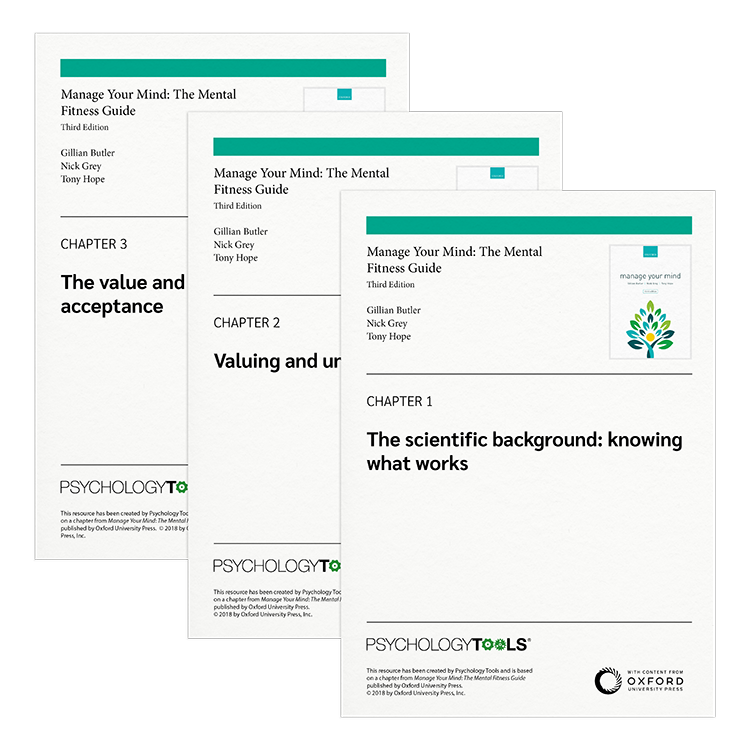
Overview
Manage Your Mind: The Mental Fitness Guide is an invaluable and comprehensive resource for therapists and clients that aims to enhance psychological well-being using effective therapeutic tools and strategies. Authored by renowned clinicians Gillian Butler, Nick Grey, and Tony Hope, this third edition combines cognitive behavioral therapy (CBT) with modern insights from positive psychology, mindfulness, neuroscience, and health psychology.
The guide is structured in a modular format, allowing for flexible use. Drawing on over two decades of clinical experience, this edition expands on the original CBT foundation by incorporating strategies that promote flourishing and meaningful living - not just symptom reduction.
Published under license from Oxford University Press, this title is now available through Psychology Tools, providing therapists and clients with a powerful resource for promoting mental wellness across a variety of presentations.
Why use this resource?
Manage Your Mind: The Mental Fitness Guide provides a practical framework for addressing a wide range of psychological difficulties.
- Combines CBT techniques with newer developments such as acceptance-based strategies.
- Offers practical, problem-specific interventions for a variety of difficulties, including anxiety, low mood, and trauma.
- Includes chapters on increasing happiness, enhancing creativity, and developing healthy relationships.
- Supports symptom reduction and personal growth.
Key benefits
Comprehensive
Accessible
Integrative
Trusted
What difficulties is this for?
Depression
Addresses low mood and reduced motivation.
Anxiety Disorders
Supports work with panic, worry, phobias, and social anxiety.
Trauma
Includes chapters dedicated to traumatic experiences.
Substance Misuse
Supports clients struggling with problematic habits and addictions.
Personal Development
Includes chapters on time management, creativity, happiness, and self-care.
Integrating it into your practice
Assess
Identify your client’s difficulties and personal goals.
Select
Choose chapters that match your client's needs.
Share
Review relevant chapters in-session or assign for homework.
Reflect
Discuss what the client has learned from the resource.
Review
Revisit relevant sections as clients face new challenges or transitions.
Theoretical background and therapist guidance
Manage Your Mind: The Mental Fitness Guide draws primarily from cognitive behavioral therapy (CBT) and is enriched by developments in contextual CBT, such as mindfulness, acceptance-based approaches, and values clarification. The guide incorporates foundational strategies like behavioral activation and graded exposure, while also introducing techniques grounded in neurobiology, behavioral economics, and health psychology.
The book is organized into three sections:
- Part I: Making sense – helps clients understand themselves, develop self-acceptance, and identify core values.
- Part II: Making your way – offers practical tools to foster emotional balance, develop positive habits, increase happiness, and navigate relationships.
- Part III: Overcoming difficulties – provides targeted interventions for specific psychological challenges, including anxiety, depression, trauma, addictions, and health problems.
Each section can be used independently or as part of an integrated treatment plan.

What's inside
- 33 accessible and informative chapters.
- Strategies for identifying values, building habits, improving emotional resilience, and managing distress.
- Helpful worksheets and reflective exercises to support change.
FAQs
How this resource helps improve clinical outcomes
Manage Your Mind: The Mental Fitness Guide helps therapists:
- Deliver effective, structured, and flexible interventions across a wide diagnostic range.
- Equip clients with helpful tools for improving their mood, motivation, relationships, and overall wellbeing.
- Increase client mastery and autonomy by providing structured, self-help resources that can be used independently.
References and further reading
- Abrams, R. (2013). When Parents Die. London: Routledge.
- Alberti, R.E. and Emmons, M.L. (2008). Assertiveness and Equality in Your Life and Relationships (9th edn.). New York: Impact.
- Allen, D. (2015). Getting Things Done: The Art of Stress-Free Productivity. London: Piatkus.
- Allcott, G. (2016). How to be a Productivity Ninja. London: Icon Books.
- Ariely, D. (2009). Predictably Irrational. New York: HarperCollins.
- Ariely, D. (2012). The (Honest) Truth about Dishonesty. New York: HarperCollins.
- Atkinson, A. (2014). The Creative Problem Solver: 12 Smart Problem-Solving Tools to Solve Any Business Challenge. Harlow: Pearson Education Limited.
- Baker, D. and Stauth, C. (2004). What Happy People Know: How the New Science of Happiness can Change Your Life for the Better. New York: Saint Martin’s Griffin.
- Baumeister, R.F. and Tierney, J. (2011). Willpower: Why Self-Control is the Secret to Success. London: Penguin Books.
- Berne, E. (2016). Games People Play: The Psychology of Human Relationships. London: Penguin Books.
- Branch, R. and Wilson, R. (2010). Cognitive Behavioural Therapy for Dummies (2nd edn). Chichester: Wiley.
- Brockman, J. (ed.) (2016). Thinking: The New Science of Decision-Making, Problem Solving and Prediction. New York: HarperCollins.
- Burch, V. and Penman, D. (2013). Mindfulness for Health: A Practical Guide to Relieving Pain, Reducing Stress and Restoring Wellbeing. London: Piatkus.
- Butler, G. (2016). Overcoming Social Anxiety and Shyness: A Self-Help Guide Using Cognitive Behavioral Techniques (2nd edn). London: Robinson.
- Cartwright-Hatton, S. (2010). From Timid to Tiger: A Treatment Manual for Parenting the Anxious Child. Oxford: Wiley.
- Collins-Donnelly, K. (2012). Starving the Anger Gremlin. London: Jessica Kingsley.
- Covey, S.R. (2004). The 7 Habits of Highly Effective People: Powerful Lessons in Personal Change. New York: Simon & Schuster.
- Cresswell, C. and Willetts, L. (2007). Overcoming Your Child’s Fears and Worries. London: Robinson.
- Currey, M. (2013). Daily Rituals. New York: Alfred A. Knopf.
- Dalton-Bradford, M. (2014). On Loss and Living Onward: Collected Voices for the Grieving and Those Who Would Mourn with Them. Sanger, CA: Familius.
- Davey, G., Cavanagh, K., Jones, F., Turner, L., and Whittington, A. (2012). Managing Anxiety with CBT for Dummies. London: Wiley.
- Davies, W. (2016). Overcoming Anger Management and Irritability (2nd edn.). London: Robinson.
- Dolan, P. (2015). Happiness by Design. London: Penguin Random House.
- Duhigg, C. (2013). The Power of Habit. London: Random House Books.
- Dunn, E.W., Aknin, L., and Norton, M. (2014). Prosocial spending and happiness: using money to benefit others pays off. Current Directions in Psychological Science, 23, 41–44.
- Espie, C.A. (2010). Overcoming Insomnia and Sleep Problems: A Self-Help Guide Using Cognitive Behavioral Techniques. London: Constable & Robinson.
- Feldman, C. (2001). The Buddhist Path to Simplicity: Spiritual Practice for Everyday Life. London: Harper-Collins.
- Fennell, M. (2016). Overcoming Low Self-Esteem: A Self-Help Guide Using Cognitive Behavioral Techniques (2nd edn). London: Robinson.
- Ferrucci, P. (2006). The Power of Kindness: The Unexpected Benefits of Leading a Compassionate Life. New York: Tarcher/ Penguin.
- Freeman, D. and Freeman, S. (2012). You Can Be Happy. London: Pearson.
- Gawande, A. (2014). Being Mortal. London: Profile Books.
- Gigerenzer, G. (2003). Reckoning with Risk: How to Live with Uncertainty. London: Penguin.
- Gilbert, D. (2006). Stumbling on Happiness. London: Harper Press.
- Gilbert, P. (2009). Overcoming Depression: A Self-Help Guide Using Cognitive Behavioral Techniques. London: Robinson.
- Gilbert, P. (2009). The Compassionate Mind. London: Constable.
- Gompertz, W. (2015). Think Like an Artist . . . and Lead a More Creative, Productive Life. London: Penguin.
- Green, D. (2016). How Change Happens. Oxford: Oxford University Press.
- Greenberger, D. and Padesky, C. (2015). Mind Over Mood (2nd edn). New York: Guilford.
- Grenville-Cleave, B. (2012). Positive Psychology: A Practical Guide. London: Icon Books.
- Grey, N. and Clark, D.M. (2013). Panic disorder. In: Shafran, R., Brosnan, L., and Cooper, P. (eds.) The Complete CBT Guide to Anxiety, pp. 129–196. London: Robinson.
- Haidt, J. (2006). The Happiness Hypothesis: Putting Ancient Wisdom and Philosophy to the Test of Modern Science. London: Heinemann.
- Haig, M. (2015). Reasons to Stay Alive. London: Canongate.
- Hanh, T.N. (2001). Anger. London: Rider.
- Hanson, R. (2013). Hardwiring Happiness: How to Reshape Your Brain and Your Life. London: Rider.
- Harris, R. (2007). The Happiness Trap. London: Robinson.
- Harris, T.A. (2012). I’m OK, You’re OK. London: Arrow Books.
- Haybron, D.M. (2013). Happiness: A Very Short Introduction. Oxford: Oxford University Press.
- Hayes, S. and Smith, S. (2005). Get Out of Your Mind and Into Your Life. Oakland, CA: New Harbinger Publications.
- Herbert, C. and Wetmore, A. (2008). Overcoming Traumatic Stress. London: Constable.
- Hibberd, J. and Usmar, J. (2014). This Book Will Make You Sleep. London: Quercus.
- Hoggard, L. (2005). How to be Happy. London: BBC Books.
- Joseph, S. (2011). What Doesn’t Kill Us: A Guide to Overcoming Adversity and Moving Forward. London: Piatkus.
- Kahnemann, D. (2011). Thinking, Fast and Slow. London: Penguin.
- Kennerley, H. (2014). Overcoming Anxiety: A Self-Help Guide Using Cognitive Behavioral Techniques. London: Robinson.
- Konnikova, M. (2013). How to Think Like Sherlock Holmes. Edinburgh: Canongate.
- Leahy, R. (2006). The Worry Cure: Stop Worrying and Start Living. London: Piatkus.
- Martin, P. (2010). Making Happy People: The Nature of Happiness and its Origins in Childhood. London: Harper Perennial.
- McCartney, M. (2014). Living with Dying. London: Pinter & Martin.
- McIlwraith, H. (2001). Coping with Bereavement. Oxford: Oneworld.
- McKay, M., Honeychurch, C., and Fanning, P. (2005). The Self-Esteem Companion. Oakland, CA: New Harbinger Publications.
- McKay, M., Rogers, P., and McKay, J. (2001). When Anger Hurts. Oakland, CA: New Harbinger.
- Meares, K. and Freeston, M. (2015). Overcoming Worry and Generalized Anxiety Disorder (2nd ed.). London: Robinson.
- Morris, D.J. (2015). The Evil Hours: A Biography of Post-Traumatic Stress Disorder. New York: Mariner Books.
- Murphy, J. (2011). Assertiveness: How to Stand up for Yourself and Still Win the Respect of Others. CreateSpace Paperbacks.
- Neff, K. (2011). Self-Compassion: The Proven Power of Being Kind to Yourself. New York: William Morrow.
- Nettle, D. (2005). Happiness: The Science Behind Your Smile. Oxford: Oxford University Press.
- Nickerson, R.S. (1999). Enhancing creativity. In: Sternberg, R.J. (ed.) Handbook of Creativity, pp. 392–430. Cambridge: Cambridge University Press.
- Oettingen, G. (2014). Rethinking Positive Thinking: Inside the New Science of Motivation. New York: Penguin Publishing Group.
- Ornstein, R. (1991). The Evolution of Consciousness. New York: Touchstone.
- Otto, M. and Smits, J. (2011). Exercise for Mood and Anxiety: Proven Strategies for Overcoming Depression and Enhancing Well-being. New York: Oxford University Press.
- Owen, R. (2014). Living with the Enemy. London: Routledge.
- Patterson, K., Grenny, J., McMillan, R., and Switzler, A. (2011). Crucial Conversations: Tools for Talking When Stakes are High (2nd edn). New York: McGraw-Hill.
- Puett, M. and Gross-Loh, C. (2016). The Path. New York: Simon and Schuster/ Viking.
- Rowe, D. (2003). Depression: The Way Out of Your Prison (3rd edn). Hove: Routledge.
- Rubin, G. (2015). Better than Before. London: Two Roads.
- Salzberg, S. (2010). The Force of Kindness. Boulder, CO: Sounds True.
- Schmidt, U. and Davidson, K. (2004). Life After Self-Harm: A Guide to the Future. Hove: Brunner-Routledge.
- Seelig, T. (2012). inGenious: A Crash Course on Creativity. New York: HarperOne.
- Seligman, M. (2003). Authentic Happiness. New York: Simon & Schuster.
Shafran, R., Brosnan, L., and Cooper, P. (eds.) (2013). The Complete CBT Guide for Anxiety. London: Robinson. - Silove, D. and Manicavasagar, V. (2009). Overcoming Panic and Agoraphobia. London: Robinson.
- van der Kolk, B. (2014). The Body Keeps Score: Mind, Brain and Body in the Transformation of Trauma. London: Penguin/ Viking.
- Walker, A. (1983). The Colour Purple. New York: The Women’s Press.
- Walker, P. (2013). Complex PTSD: From Surviving to Thriving. Lafayette, CA: Azure Coyote Publishing.
- Warburton, N. (2007). Thinking from A to Z (3rd edn). London: Taylor and Francis Group.
- Webb, J. (2012). Running on Empty: Overcome your Childhood Emotional Neglect. New York: Morgan James Publishing.
- Weinstein, N. and Ryan, R. (2010). When helping helps: autonomous motivation for pro-social behaviour and its influence on well-being for the helper and the recipient. Journal of Personality and Social Psychology, 98, 222–244.
- WebsiteJamesClear.com. How to Build a New Habit: This is Your Strategy Guide. Retrieved from: http://jamesclear.com/habit-guide
- Williams, M. and Penman, D. (2011). Mindfulness: A Practical Guide to Finding Peace in a Frantic World. London: Piatkus.
- Williams, M., Teasdale, J., Segal, Z., and Kabat-Zinn, J. (2007). The Mindful Way Through Depression: Freeing Yourself from Chronic Unhappiness. New York: The Guilford Press.
- Wood, W. and Runger, D. (2016). Psychology of habit. Annual Review of Psychology, 67, 289–314.
Just enter your name and email address, and we'll send you Manage Your Mind: The Mental Fitness Guide (Third Edition) (English US) straight to your inbox. You'll also receive occasional product update emails wth evidence-based tools, clinical resources, and the latest psychological research.
Product
Company
Support
- © 2026 Psychology Tools. All rights reserved
- Terms & Conditions
- Privacy Policy
- Cookies Policy
- Disclaimer
Working...
We value your privacy
This site uses strictly necessary cookies to function. We do not use cookies for analytics, marketing, or tracking purposes. By clicking “OK”, you agree to the use of these essential cookies. Read our Cookie Policy
